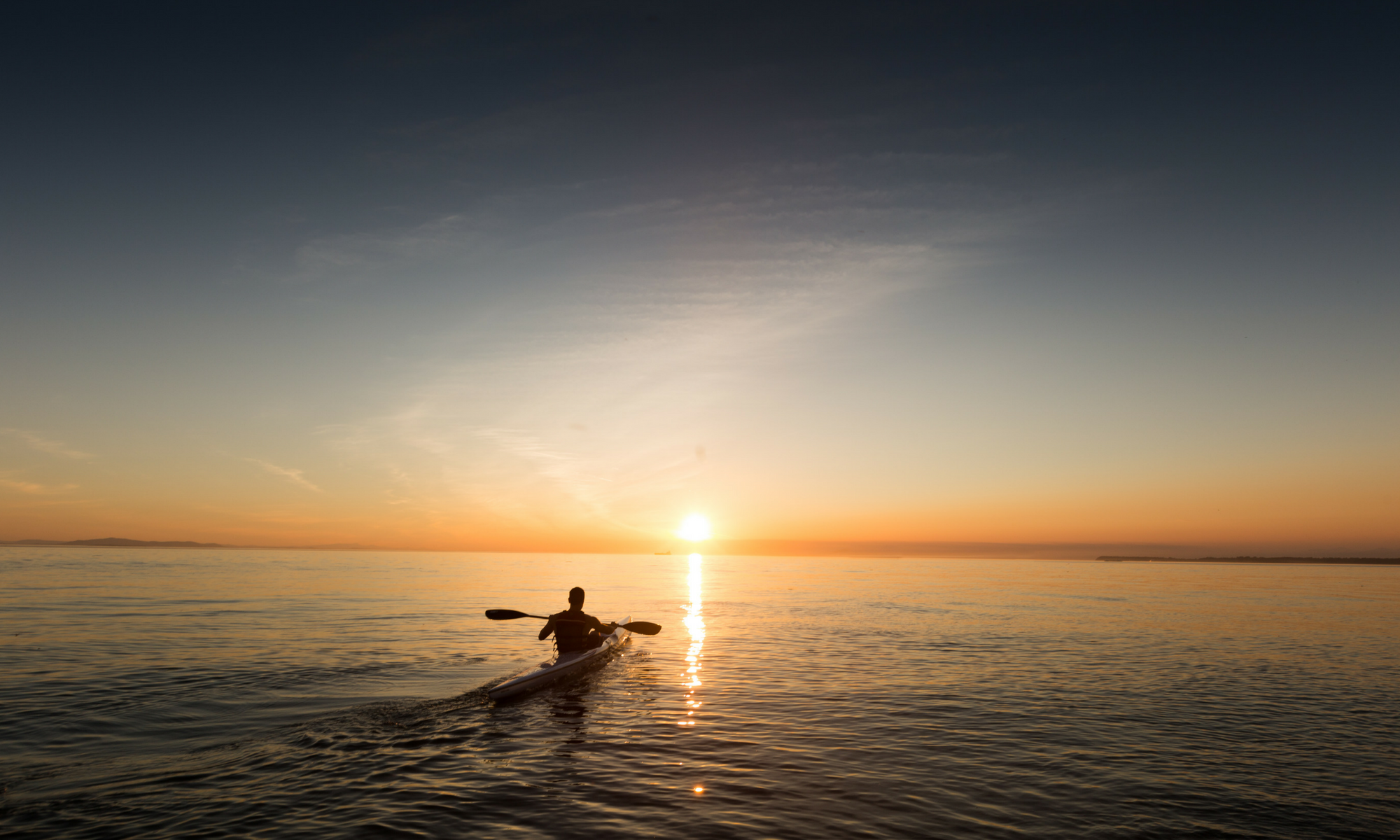Jump Ahead To:
BEST KAYAK PADDLE LEASH: INTRO
Losing your paddle during an intense kayak fishing outing can happen to anyone! Instead of watching your paddle slowly float away, you should serious consider purchasing the best kayak paddle leash for optimal security!
Best Kayak Paddle Leash: Overview

Please note: This post contains affiliate links. An affiliate link means that we may earn advertising/referral fees if you make a purchase through our links.
Most people don’t know that there’s more to a leash than what they can see. I’ve prepared this guide to help you understand more about kayak paddle leashes. For better readability, I’ve divided the guide into several sections.
The first section talks about the basics of kayak paddle leashes – what are they, what are they used for, what materials are the made of, how to install them, and so on. It also includes why you need them and, perhaps more importantly, when NOT to use them.

The second section is a step-by-step “how-to” guide covering both the proper use of the paddle leash and the correct way to attach the paddle leash.
After that, we go over the important considerations that you need to contemplate before buying a paddle leash of your own. It includes what to look for in the leash, as well as the accessories you’ll be needing. This will turn you into a knowledgeable consumer and you’ll be able to separate the “good” paddles leashes from the “bad” in no time!

Finally, I’ve including a link to my favorite model. Frankly, I think its the best kayak paddle leash on the market, but there are a handful of other top notch models as well. I chose this leash based on my own experience, which you can read about in the “My Experience” section. You’ll also find a summary of my thoughts here in bullet format.
So without any further ado, let’s get started with the guide!
Parts of a Kayak Fishing Paddle
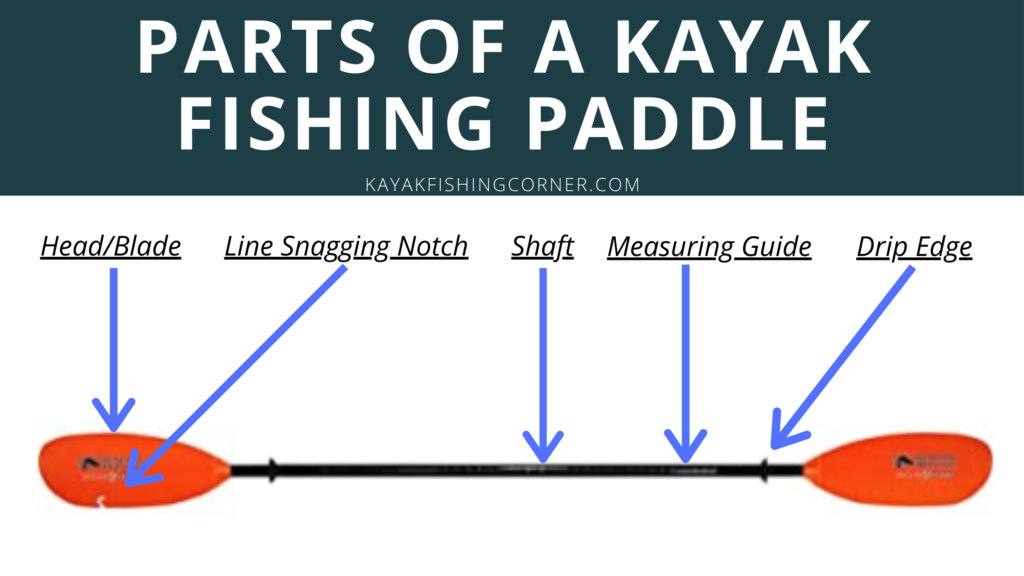
Best Kayak Paddle Leash – Basics:

Please Note: As an Amazon Associate, I earn from qualifying purchases.
Shortcut to Best Kayak Paddle Leash Review
Investing in a kayak paddle leash may not be as important for some people. After all, kayak fishermen tend to like the “flashier” types of kayak fishing gear like kayak outriggers (after they’ve learned how to use a kayak outrigger, of course) and kayak anchor trolleys (learn how to use a kayak anchor trolley). But there are some immediate benefits to the kayak paddle leash that should not be overlooked!
Also called a tether, your paddle leash will prevent your paddle from floating away downstream in the event that you lose your grip on it or it accidentally floats away while you are focusing on your catch. It is quite distressing, as kayaks only have one paddle…

Soon you’ll be stuck trying to use your hands to paddle the kayak. Or worse, jumping in the water and swimming to catch it! And if the current is too strong, you’ll lose sight of your paddle almost immediately. Like the saying goes, you would be “up a creek without a paddle”.
On the subject of when to use a kayak paddle leash, it’s important to know when not to use them too. Do not use a kayak paddle leash if you’re kayaking on whitewater, rivers, or heavy current. Your leash will get caught in something, and your kayak may tip over. Or worse, you could be pulled into the water.

Obviously the paddle leash could also pose a risk of entanglement with the kayaker. Most leashes do have “break away” safety features, but you don’t want to rely on that when your life could be on the line. That is why every professional will warn against binding any part of the leash to your body. Keep everything between your paddle and your kayak’s deck!
How to Use the Best Kayak Paddle Leash:

Installing and removing a kayak paddle leash is quite simple. Here’s a step-by-step process on how to use the best kayak paddle leash:
- Unbox the leash, including any hooks and carabiners.
- Attach all the parts if they come disassembled.
- The parts will include: the main leash, two loops on either side, or one loop, and one carabiner.
- If your leash has two loops, pass one loop (the non-adjustable one) through a pad-eye.
- The loop can be passed through any accessory attachment hook, but pad-eyes work best.
- Now pass the other adjustable loop through the first loop, then pull to tighten the first loop.
- The second adjustable loop can now be tightened around your paddle’s shaft.
- You may need to break your shaft into two parts to attach the loop (especially if you have an adjustable kayak paddle).
- If your leash has one loop and a carabiner, hook the carabiner on the pad-eye or accessory hook.
- And then tighten the loop around the shaft of the paddle.
- Many leashes come with Velcro on the adjustable loop to secure it in place.
- It is best to tighten the leash around the middle of the shaft since you need to move the paddle.
Side Note: If you are interested in this post, then you might also want to take a look at pairing your paddle leash with the Best Kayak Paddle for Fishing or the Best Kayak Paddle for the Money!
Best Kayak Paddle Leash – Important Features:

Length and Flexibility of the Leash:
When you’re buying a paddle leash, the length and the level of flexibility is crucial to consider. Kayak paddle leashes are made to be compact when retracted. However, some can be as long as 6 feet when fully stretched.
Going slightly over the required length is a good idea. But remember that leashes can get snagged in objects easily. So keep the leash only a few inches above the requirement, to allow for extra mobility.

When retracted, most tethers are around 3.5 feet long. A shorter leash will create resistance to the movement of the paddle. Short leashes will also hinder you from placing your paddle wherever you want on the kayak. As with everything else in life, you must find a balance. There are serious downsides to using too long or too short of a leash!
Type of Leash:
There are essentially three different types of leashes. First, we have the coiled leash. Coiled tethers are made from a coiling of stretchy material. These leashes are normally very easy to stretch, providing effortless paddling.
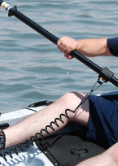
However, be careful with these, as they have a limit to how far they can stretch. The inner core will likely feature stainless steel. So once you’ve exhausted the length of the steel wire, the leash won’t extend any further.
Bungee leashes, only the other hand, are much more versatile in terms of flexibility and length. They use a professional bungee cord on the inside, which is prone to stretching and straining as you will.
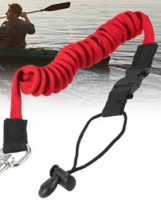
And most bungee leashes come with a nylon cover. But be warned: they aren’t very good at retracting (once they have aged, that is). So you may end up with a paddle leash that has “stretched out” over time.

Finally, we have the straight cable leashes. They are made a single line of elastic nylon. They can stretch well beyond the capabilities of a coiled leash. And the best part is that they’re highly versatile. But they are lesser preferred due to their lower durability.
Leash Covering:
Perhaps the most neglected aspect of a kayak paddle leash, the cover of the tether is something to consider as well. Most tethers use either stretchable nylon or vinyl.
Nylon is a durable choice, and almost every bungee leash uses it. However, it isn’t entirely waterproof. It doesn’t mean that manufacturers won’t have applied some form of a waterproof coating on the cover.

Vinyl is a better choice, as the fabric itself is waterproof. But there’s usually a limit here as well. The cover of the leash is important as it’s your first line of defense against water.
Regardless of what kind of material is used in the cover – we like for paddle leashes to be brightly colored (red, yellow, orange, etc.) to provide you, and those around you, with extra safety due to your increased visibility on the water. Every little bit helps!
Coil Material:
If you’re going for a coil leash, then consider the material of the coil. Almost all kayak paddle leashes use a stainless steel coil. Stainless steel is the best choice here, as it’s strong, sturdy, and waterproof.

For convenience’s sake, grade 316 steel is used in coil leashes. It is commercial-grade steel, which is just strong enough for most regular uses. Avoid coils that use aluminum, as this is not durable and can snap very easily.
Hooks and Pad-Eyes:
The set up of the leash requires an accessory attachment hook or pad-eye to be present on your kayak. The instructions manual of your kayak will highlight what type of hook is best used with your kayak.
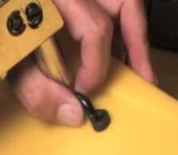
If your kayak doesn’t have spare pad-eyes, especially near the deck, then you need to install them. Don’t worry. This is not very difficult at all. You can find pad-eyes from any local hardware store or online. You’ll also need well nuts and bolts to attach the pad-eyes, which you’ll get with the pad-eyes included. This may sound daunting, but it is a VERY easy install.
Buy The Best Kayak Paddle Leash:
From what I’ve experienced, the best kayak paddle leash is the model that we’ve showcased above. This leash is highly durable, rust-resistant, and has versatile applications – each combining to make it perfect for kayak fishermen of any level of skill of experience.
Let me first start by saying that this is a coiled leash. As I’ve stated before, coiled leashes are the best as they are highly flexible and suitable for most end-users.

The material sued for the coil is stainless steel that makes the leash both waterproof and resistant to damage by salt (an important consideration for those KFC readers who frequently go kayak fishing in the ocean (in which case we suggest you look into getting a kayak outrigger for ocean based kayak fishing)).
But it’s not just the coil that is made of stainless steel. In fact, the hook of the carabiner is also made with grade 316 steel.
When retracted, the leash is around 3 feet or 36 inches long. When fully stretched, the leash extends to up to 6 feet. It is quite surprising, considering most coiled leashes aren’t suitably long. This is very, very close to ideal. The 36″ retracted length won’t “get in the way” of your stroke, while the 6 foot extended length is long enough to accommodate even the wackiest of paddling motions!
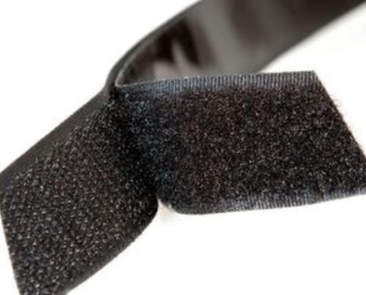
One end of this leash has a Velcro strap and a loop, while the other has a carabiner. The carabiner-loop setup is the best for more elderly kayak fishermen or those with joint issues, as you don’t need to tighten any loops.
The material used for the coating is unknown, actually, but I’m assuming it is waterproof. One other thing I really liked about this tether is that it’s bright red in color. Remember how we discussed the importance of bright coloration in terms of safety on the water? Also, you can see it easily, in case the leash gets lost in the water – an added benefit!
Additionally, the paddle leash can be used for other purposes as well. You could, for example, tie your kayak to a post or a dock. Or you could use it to tether fishing poles and other valuables. You can even repurpose it for your canoe, paddleboard, and even a sailboat. This is all possible because of the simple, yet sophisticated, design of the paddle leash – its versatility of use almost makes it seem like a “two for one”!

Lastly, this paddle leash is highly affordable. It’s not the cheapest, but a low price means low quality. The leash fits perfectly into the price range – not too costly and not too cheap. You do NOT need to overspend on a kayak paddle leash, save your money for those more expensive pieces of kayak fishing gear (like the Deeper Start Smart Fish Finder)!
The only concern you may have is that it uses a carabiner instead of two loops. I stated before that the carabiner is easier to use. But a loop is more secure. This is one of those instances of “personal preference” and every kayak fishermen is a bit different than the next!
My Experience

Why do I like this particular paddle leash? It’s highly durable, flexes just fine, and provides a wide range of motion. The fact that it’s not too short nor too long when retracted means I can use my paddle without it getting snagged.
I did have the concern that, since it was a coiled leash, it would have a shorter stretching limit. It does as compared to bungee leashes. But it can extend up to 6 feet, which is more than enough for anyone.
Here’s a summary of my thoughts in an easy to reference “pro” and “con” list:
Pros:
- Long and flexible for all uses.
- Highly visible in the water (bright red color).
- Rust and salt-resistant stainless steel.
- Velcro strap for extra security.
- Simple and easy setup (no special tools required).
Cons:
- Carabiner (instead of loop) connection is a potential downside for some kayak fishermen.
Conclusion:

And that’s the end of the guide! I hope my knowledge of kayak paddle leashes helped you understand a lot about them. And I hope this guide enlightened you on the various aspects of kayak paddle leashes. We certainly covered a lot, didn’t we?!
No doubt, the kayak paddle leash that we showcased above is the best kayak paddle leash on today’s market. It’s highly affordable, offers rust-resistance, and even the clips are waterproof.
Look, there are other paddle leashes on the market, and some others are even very good quality. However, if your kayak fishing style aligns with mine, I think you’ll be happy with our showcased model – I know that I am!
Comments

Did you know that a kayak paddle leash was such an important piece of kayak fishing gear? We have noticed that have been becoming increasingly more common on the kayak fishing scene in the last couple of years!
Do you use a paddle leash? Have you had any experience with the one that we’ve showcased above? Please share your experiences and stories with us by posting on the Comments board below. We read and reply to every comment and love interacting with the kayak fishing community!
